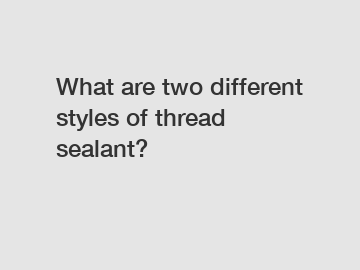What are two different styles of thread sealant?
DELONG supply professional and honest service.
What are two different styles of thread sealant?
Thread sealants are essential for preventing leaks and ensuring a secure fit when connecting pipes and fittings. They provide a reliable seal against liquids and gases, making them crucial in various industries, including plumbing, oil and gas, and manufacturing. When it comes to selecting the right thread sealant, there are two primary styles to choose from: tape sealants and liquid sealants. Let's explore these styles further and understand what sets them apart.

Tape Sealants:
1. Composition and Usage:
One of the most popular thread sealant styles is tape sealants, commonly known as Teflon tape or plumber's tape. It is made of polytetrafluoroethylene (PTFE), a high-performance plastic known for its excellent chemical resistance and nonstick properties. The tape is thin and flexible, making it easy to wrap around pipe threads.
Tape sealants are typically used on tapered pipe threads, where they fill the gaps and create a tight seal. The tape acts as a lubricant during assembly, allowing easy tightening without damaging the threads. It also helps to prevent galling or seizing of metal threads.
2. Application Tips:
Applying tape sealants correctly is vital for achieving an effective seal. Here are a few pointers to keep in mind:
a) Start applying the tape from the end of the pipe and wrap it in the opposite direction of the thread rotation. This ensures that the tape will not unravel during assembly.
b) Stretch and pull the tape slightly to increase its width as you wrap it around the threads. This helps to create a thicker seal and better filling of gaps.
c) Use a few wraps of tape for smaller diameter threads and increase the number of wraps for larger diameter threads. Aim for a snug fit without excessive tape overlapping.
3. Advantages and Limitations:
Tape sealants offer several advantages:
a) Versatility: Teflon tape can be used on different types of pipe materials, such as metal, plastic, and even rubber. This versatility makes it a go-to option for many applications.
b) Ease of Use: Applying tape sealants is relatively simple and doesn't require any curing time. The tape can be easily removed or adjusted if needed during assembly.
c) Cost-Effective: Teflon tape is an affordable option compared to other thread sealant styles. A single roll can last for multiple applications, making it a cost-effective solution.
However, tape sealants have a few limitations:
a) Thickness: Being a thin material, Teflon tape might not be suitable for extremely high-pressure or high-temperature applications. In such cases, a thicker sealant may be more appropriate.
b) Skill Dependent: Proper application of tape sealants requires some skill and technique. Beginners may find it challenging to achieve a consistent and effective seal, resulting in leaks.
Liquid Sealants:
1. Composition and Usage:
Liquid sealants, also known as pipe dope or thread compound, are viscous substances applied directly to the threads. They typically come in paste or liquid form and are designed to fill gaps and form a seal as they cure or harden.
Liquid sealants are ideal for sealing both tapered and straight threads and are commonly used in applications where high pressures and temperatures are involved. The sealant forms a reliable bond with the pipe material, preventing leaks and ensuring a secure connection.
2. Application Tips:
When using liquid sealants, consider the following tips:
a) Clean the threads thoroughly before applying the sealant to ensure proper adhesion.
b) Apply the sealant evenly and avoid excessive application that leads to drips or runs.
c) Follow the manufacturer's instructions regarding curing or drying time before pressurizing or using the assembly.
3. Advantages and Limitations:
Liquid sealants offer several advantages:
a) Enhanced Performance: Liquid sealants are often preferred for high-pressure or high-temperature applications. They provide a stronger and more durable seal that can withstand challenging conditions.
b) Easy Application: Liquid sealants are ready to use and easily applied with a brush or by hand. Their viscosity ensures good coverage and filling of gaps.
c) Versatility: These sealants can be used on various pipe materials and thread types, making them a versatile choice.
However, liquid sealants also have some limitations:
a) Curing Time: Unlike tape sealants, liquid sealants require a curing or drying time before the assembly can be pressurized. This can prolong the overall installation process.
b) Messy Cleanup: Liquid sealants can be messy to work with, especially when excess sealant needs to be removed. It is important to follow proper cleanup procedures and use appropriate solvents if required.
In conclusion, when it comes to thread sealants, both tape sealants and liquid sealants have their unique advantages and suitability for different applications. Tape sealants are widely used for their ease of application and cost-effectiveness, while liquid sealants offer enhanced performance and durability. Selecting the appropriate thread sealant style depends on factors such as pressure, temperature, pipe material, and personal preference.
If you are looking for more details, kindly visit our website.
For more virgin ptfe sheetinformation, please contact us. We will provide professional answers.



